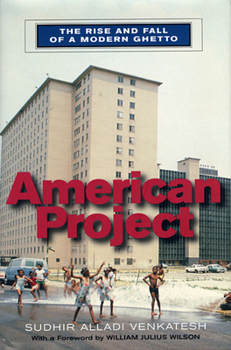American Project: The Rise and Fall of a Modern Ghetto
Select Format
Select Condition 
Book Overview
High-rise public housing developments were signature features of the post-World War II city. A hopeful experiment in providing temporary, inexpensive housing for all Americans, the "projects" soon became synonymous with the black urban poor, with isolation and overcrowding, with drugs, gang violence, and neglect. As the wrecking ball brings down some of these concrete monoliths, Sudhir Venkatesh seeks to reexamine public housing from the inside...
Format:Paperback
Language:English
ISBN:0674008308
ISBN13:9780674008304
Release Date:April 2002
Publisher:Harvard University Press
Length:360 Pages
Weight:0.88 lbs.
Dimensions:0.9" x 6.1" x 9.3"
Customer Reviews
3 ratings
One of the best books on public housing in Chicago
Published by Thriftbooks.com User , 14 years ago
GREAT BOOK!!!!!!! Venkatesh provides a very detailed discussion of the infamous Robert Taylor Homes. He is sensitive and fair to those who called it home and community, but realistic as any outsider should and must be. If one only listens to the perspectives of public housing residents, particularly those displaced from distressed buildings, such as the Robert Taylor Homes, one will only get a biased account, and arrive at wrong or misguided conclusions. Within the first several years of their existence, the Robert Taylor Homes quickly became among Chicago and the nation's worst public housing, a dubious distinction that would last until the buildings were razed several years ago. Venkatesh's historical analysis is well supported and substantiated.
A sociologist explores life in a public housing high-rise
Published by Thriftbooks.com User , 21 years ago
Venkatesh has done a superb job of describing the interrelationships between tenants, and the relationship between tenants and management, as well as chronicalling the changes in these relationships since Robert Taylor was constructed in the early 60's. Anyone who wants to move beyond the headlines, and find out more about the strengths and weaknesses of life in a public housing development should read this book.That said, the author's background and training as a sociologist comes through loud and clear, and ultimately limits his book. While Venkatesh does a good job of detailing the social relationships among the players, he virtually ignores the larger political issues. Why was management so inept as to be virtually non-existent? Why did the drug/crime culture take hold, and how did the gangs transfor themselves into multi-state corporate enterprises? Most importantly, given that CHA is now in the process of demolishing virtually everyone of the buildings which form Robert taylor Homes, how do we avoid creating the same problems in the next generation of public housing.Excellent bibliography, by the way. A very good place to dig for resources for anyone wanting to study the history of the Chicago Housing Authority since 1960.
Life at the CHA Robert Taylor Homes in Chicago
Published by Thriftbooks.com User , 23 years ago
Venkatesh describes his research experience at the Robert Taylor Homes in Chicago in a readable and engaging style. His work, while at the University of Chicago, was a result of interviews, traditional research of literature and "hanging out." With the residents, the CHA staff, the resident leadership and the gangs which had a variety of community, business and narcotics interests.Traditional property management services were not provided to CHA residents as a matter of right. Instead, a complicated set of rules violations (reporting income, reporting household composition), payoffs, relationship brokering, "hustle," and an underground economy emerged to get basic services (repairs, heat, security, etc.) to the residents of Robert Taylor.In the beginning the "brokerage" was provided by the resident leadership (the Local Advisory Council)and the CHA staff. Gradually, with the emergence of the drug economy, the role was assumed by the gang/drug interests which really controlled conditions at the CHA family developments like Robert Taylor. The police and other traditional service institutions ceded their responsibilities to these interests. And public housing developments like Robert Taylor became "free crime" zones.The CHA is presently engaged in highly innovative "Plan for Transformation" whereby all of the 25000 units of family and senior housing has been put under private management during the past year, and the CHA high rises are being vacated as part of an effort to replace them with mixed income, mixed use communities, where resident services are provided as a matter of course, and the public housing developments are to be integrated into the larger community structure of which they are a part.It is in this area where the Venkatesh book falls short. How is the 30 year history of neglect, self help and petty crime at Robert Taylor to be integrated into this new future where marketplace services and safety will be the norm, and CHA residents will live in housing and community life which is thoroughly integrated into the mainstream economy and culture?This book is a "must read" for anyone interested in the transformation of public housing in America's major cities and the possibilities for bringing content to the concept of "compassionate conservatism" in the redevelopment of public housing dominated inner city communities.Don Samuelson - DSSA Lawyer, developer and private manager of CHA housing





